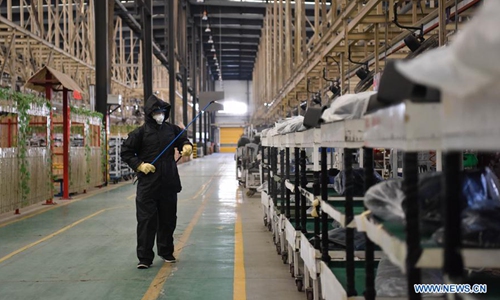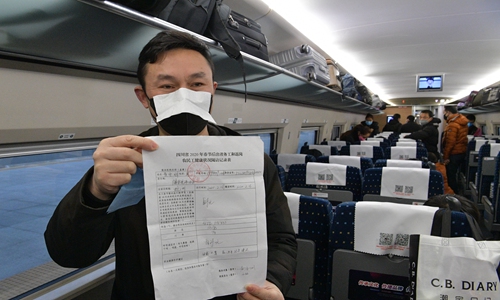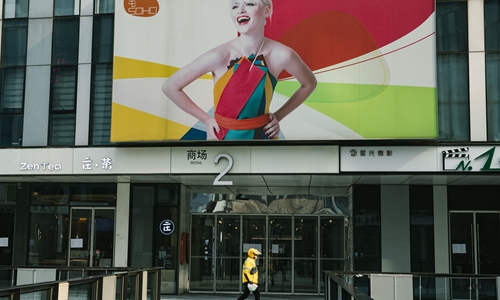Slow, steady economic reboot
As big firms resume work, small businesses face obstacles

A worker disinfects the factory of Chang'an Automobile in Dingzhou, north China's Hebei Province, Feb. 16, 2020. Companies in Dingzhou resumed production with epidemic prevention measures during the outbreak of the novel coronavirus. (Xinhua/Zhu Xudong)
China's intensifying efforts to resuscitate the economy after a near standstill for several weeks due to the outbreak of the deadly coronavirus have got off to a slow yet steady start, as more larger, state-owned companies are resuming operations but many smaller factories and businesses still confront difficulties to resume operations given the tremendous risks and obstacles.
The slow resumption of economic activities underscored the challenges that officials face in reviving the world's second-largest economy, even as efforts to combat the epidemic have yielded promising signs in areas outside of Hubei, the epicenter of the outbreak, experts noted. But the pace of businesses resuming production will likely pick up this week and full operations can be expected as soon as the end of this month, they said.
Large, state-owned companies have led the way to resuming production as top officials called for intensified efforts to stabilize economic growth. Many provinces have reported that more than 50 percent have resumed operations, including traditional manufacturing powerhouses like East China's Jiangsu, Zhejiang and Fujian provinces. In other provinces such as Shandong reported that up to 70 percent of major industrial firms have resumed operations, according to official data on Monday.

Huang Shougang, a migrant worker, shows his health record on a train bound for Hangzhou, East China's Zhejiang Province in transit from Chengdu, Southwest China's Sichuan Province on Monday. More than 750 migrant workers took the G4391 bullet train to Hangzhou to return to work in order to meet the demand of enterprises. Photo: cnsphoto
However, major industrial firms, which have an annual sales revenue of above 5 million yuan ($716,712), only represent a portion of China's massive economy, where small and medium-sized enterprises (SMEs) and the service sector contribute hugely to GDP growth.
Pictures of empty offices, buses and subway trains circulating online have also accentuated the slow and challenging process of jumpstarting economic activities. The number of businesses that have returned to operations nationwide may still be significantly low, according to some indicators.
Official data from the Ministry of Transportation showed that the number of passengers on the nation's transport network since the end of the Chinese New Year holiday has dropped from more than 82.3 percent year-on-year to 238 million as of Friday.
This means that only between 23 percent and 37 percent of workers have returned to work compared to 95 percent in previous years after the Chinese New Year holiday, according to CITIC Securities.
Another reliable indicator of economic activity - daily coal consumption by six of the country's biggest power companies have dropped to below 400,000 tons, about 30 percent of that of normal times, CITIC Securities said in a research note on Monday.
Many sectors, including logistics and steel production, have also only seen resumption rates of around 30 percent, according to several surveys.
"This is not business as usual. Companies cannot just turn on the machines and start production like they did after the Chinese New Year in previous years. There are more challenges they are facing that will take more time to overcome before returning to normal," Cao Heping, a professor of economics at Peking University in Beijing, told the Global Times on Monday, adding that it would take at least two more weeks for "most of the businesses" to return to full operation.

A delivery man walks by a building in the downtown Sanlitun shopping area in Beijing on Wednesday, which is the third day the city officially resume work. As most companies and government institutes decided to let employees work at home during the epidemic, few people can be seen in Sanlitun, which is one of the city's busiest districts. Photo: Li Hao/GT
Obstacles and risks
China's top officials have called for more focus and stronger measures to revive the economy, while continuing the efforts to battle against the epidemic. Various central government agencies have even rolled out policies, including fiscal support, to help companies resume production.
However, businesses across the country continue to face a combination of obstacles and risks in returning to production.
In a symbol of those difficulties faced by businesses, a screenshot of what appears to be an application from a company in Luzhou, Southwest China's Sichuan Province went viral on social media on Monday.
The application for resuming operations contained in total nine approval stamps - one appears to be the company's own and the other eight came from various departments in the city, including the official in charge of the city's efforts against the epidemic.
"These are unintended consequences of the battle against the epidemic, and the restrictive measures put in place to stop the virus have also restricted companies from resuming production," Tian Yun, director of the China Society of Macroeconomics Research Center, told the Global Times on Monday, "In some places, officials have taken the battle to a whole new, unnecessary level."
Some companies have to submit as many as 21 documents, including a 15-page application form, plans for operations and emergencies and two letters of commitment, to local officials, according to Xinhua News Agency.
And even if they receive approval stamps, that would be just the beginning of an array of more obstacles they have to overcome before resuming operations.
"Even after the government issued a notice saying we can start operations, only 10 percent of workers have returned and we can only reopen some production lines," Chen Liang, general manager of Dongguan Jinconn New Material Holdings, told the Global Times on Monday, adding that the company is also short in cash to cover one third of its operating cost.
Extended closures for many businesses across the country will continue to weigh on economic growth in the first quarter, when GDP growth could slow to as low as around 3 percent, analysts said.
"We have been so focused on fighting against the epidemic, but the fight to save the economy is also as important, because it is directly tied to the livelihood of 1.4 billion people," Tian said, "if we can't speed up the process of resuming production, the consequences could be very dire."
However, some analysts still argue that once the epidemic is reined in, economic activities will pick up and economic growth for the full year will be stable.
"Even if the situation is very severe in the first quarter, it will be offset by gains in the second half of the year and the full-year growth will be relatively stable, despite the challenges," said Li Daxiao, chief economist at Shenzhen-based Yingda Securities.